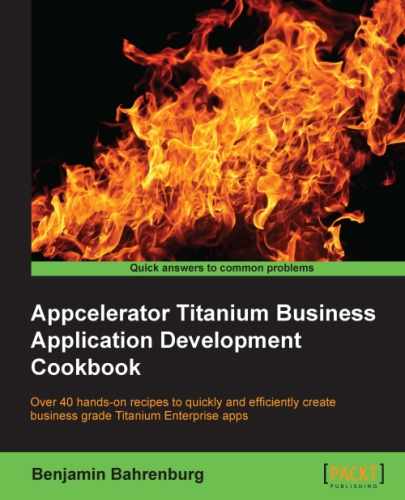- Appcelerator Titanium Business Application Development Cookbook
- Table of Contents
- Appcelerator Titanium Business Application Development Cookbook
- Credits
- About the Author
- About the Reviewers
- www.PacktPub.com
- Preface
- 1. Patterns and Platform Tools
- 2. Cross-platform UI
- 3. Using Databases and Managing Files
- Introduction
- Accessing your database's Ti.Filesystem
- DbTableChecker SQLite table existence checking
- Recursively handling files using Dossier
- Tuning your SQLite database for maximum performance
- Data access using DbLazyProvider
- NoSQL using MongloDb
- 4. Interacting with Web Services
- 5. Charting and Documents
- 6. Using Location Services
- 7. Threads, Queues, and Message Passing
- Introduction
- Queuing multiple downloads
- Launching one app from another
- Cross-platform URL schemes
- Opening your Android app with BOOT_COMPLETED
- iOS Multithreading using Web Workers
- 8. Basic Security Approaches
- 9. App Security Using Encryption and Other Techniques
- A. Titanium Resources
- Index
In this book, you will find a number of styles of text that distinguish between different kinds of information. Here are some examples of these styles, and an explanation of their meaning.
Code words in text, database table names, folder names, filenames, file extensions, pathnames, dummy URLs, user input, and Twitter handles are shown as follows: "This namespace contains common APIs such as Ti.UI.View and Ti.UI.TableView."
A block of code is set as follows:
//Create our application namespace
var my = {
ui:{
mod : require('dateWin')
},
tools:{},
controllers:{}
};When we wish to draw your attention to a particular part of a code block, the relevant lines or items are set in bold:
//Add a global event to listen for log messages Ti.App.addEventListener('app:log',function(e){ //Provide Log Message to CommonJS Logging Component my.logger.add(e); }); //Open our sample window my.ui.mainWindow.open();
New terms and important words are shown in bold. Words that you see on the screen, in menus or dialog boxes for example, appear in the text like this: " This recipe walks through using the screen break interaction pattern to create additional space for an Add Notes field."
-
No Comment
